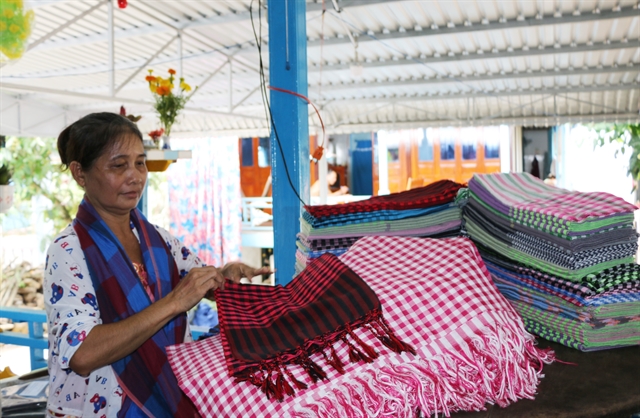 Society
Society

Craft villages in the Cửu Long (Mekong) Delta province of Đồng Tháp operate efficiently, providing steady jobs and incomes to many people.

|
| Checkered scarves made in Long Khánh A Scarf Weaving Village in Đồng Tháp Province. – VNA/VNS Photo Chương Đài |
ĐỒNG THÁP – Craft villages in the Cửu Long (Mekong) Delta province of Đồng Tháp operate efficiently, providing steady jobs and incomes to many people.
The province has the largest number of craft villages in the delta - 39 - whose workers produce ornamental flowers and plants, weaving products, processed foods, fine arts products, and others.
These are also popular destinations for both Vietnamese and foreign tourists.
The Mỹ Tân bamboo weaving village in Cao Lãnh City’s Mỹ Tân Commune makes baskets and flower pots from bamboo and provides steady jobs to locals.
Trương Văn Dũng, whose family has been making bamboo baskets for more than 10 years, said traders bought the village’s products year round.
Each worker in the village earns VNĐ3 – 4 million (US$130 - 170) a month from making the baskets.
The Định Yên sedge mat weaving village in Lấp Vò District’s Định Yên Commune, which has been recognised as an intangible national cultural heritage, has more than 3,000 workers.
The Sa Đéc flower village in Sa Đéc City, one of the country’s largest such villages, has more than 2,300 households growing flowers and ornamental plants on an area of more than 500ha.
The households earn an average of VNĐ200 million ($8,610) per hectare per year.
Võ Thanh Tùng, chairman of the city People’s Committee, said measures had been taken to promote linkages in growing flowers and ornamental plants, increase the value of products and develop tourism.
In recent years the province has taken many measures to develop and revive craft villages, including providing vocational training and financial support for craft villages to buy equipment and machinery.
Besides mechanising their production, crafts villages have diversified their products to meet market demand.
The Sa Đéc rice flour making village has expanded production to an industrial scale, has more than 2,000 workers and produces around 50,000 tonnes of rice flour a year.
Its flour is sold nation-wide and exported to Southeast Asian countries.
The Long Khánh A Scarf Weaving Village in Hồng Ngự District has been revived and is developing well, with locals diversifying their products and using mechanised looms to increase capacity.
Established more than 100 years ago, the village used to produce traditional checkered black and white scarves, but declined in 2000 – 12 in the face of intense competition.
The village then started making checkered scarves in other colours and improved their design to make them beautiful and fashionable.
The changes restored the attraction consumers used to have for them.
Besides, the village also began to make handbags, neckties, hats, and other products from its weaving cloth.
It has 120 mechanised looms with 200 permanent workers and produces nearly 1.5 million scarves a year.
They are sold mostly in the delta, HCM City and Cambodia.
According to Đặng Lệ Thủy, who has woven scarves for 30 years, the village produces year round but the busiest time is before Tết (the Lunar New Year) and the fourth lunar month.
Nguyễn Phước Thiện, deputy director of the province’s Department of Agriculture and Rural Development, said the target was to develop craft villages by getting them to adopt advanced techniques and diversify their products by 2020.
This would improve their quality and competitiveness, he added. – VNS




